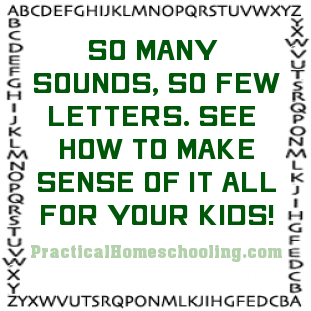 The first step in teaching a child to read is to teach the alphabet letters. As we pointed out in our previous column, that can be done easily by teaching the alphabet song or poem.
The first step in teaching a child to read is to teach the alphabet letters. As we pointed out in our previous column, that can be done easily by teaching the alphabet song or poem.
The next step is to teach the child the sounds the letters stand for. The child doesn't have to know the alphabet perfectly before going on to the second step, for he or she will continue to master the alphabet while learning the letter sounds.
No Hieroglyphs, Please
Alphabet letters, of course, are sound symbols. They don't represent apples or elephants. They represent the irreducible sounds of our language.
The invention of alphabetic writing is the result of a great discovery made by someone about 2000 B.C. That individual discovered that all of human language really consists of only a small number of irreducible speech sounds.
Prior to that discovery, human beings used pictographs and ideographs in order to record their thoughts and stories on stone, clay, or papyrus. Pictographs limited writing to only those things that could be pictured. Ideographs were symbols or characters representing concepts and abstractions that could not be pictured. Thus, scribes created thousands of ideographs that had to be memorized if you were to become literate.
The invention of alphabetic writing created a revolution in literacy. Now all you had to do was memorize these few sound symbols to become literate.
More Sounds Than Letters
As we said, all of human language is composed of a small number of speech sounds. How many are there in English? Forty-four. But we have an alphabet of only 26 letters. How did this mismatch come about? When the Romans conquered England they imposed the Latin alphabet on the Anglo-Saxons, who then adapted the Latin alphabet to their language. Which meant that some of the letters would have to stand for more than one sound, and some of the sounds would be represented by more than one letter, as in sh, ch, th.
As for a letter standing for more than one sound, the letter a stands for the long a as in apron, the short a as in hat, the a as in all, the a as in father, and the a as in care. In other words, the letter a stands for five different sounds. How do you learn which sound to articulate when you see the letter a in a word?
You must be taught these words in their spelling families. That's how you become familiar with the different sounds and their spelling forms.
And that is the key is to mastering the English alphabetic system.
What Order Should I Teach the Sounds?
While quality phonics programs differ in which letters they teach first, most start with the short vowel sounds and the hard consonant sounds. Some simply teach all these basic letter sounds in alphabet order. Others may teach them grouped by handwriting family (the itl program, which teaches i, t, and l as the first three letters) or in some other non-alphabetic fashion. A few teach all the sounds of each "phonogram" (a sound unit consisting of one or more letters, e.g., a, sh, scr, ough) at once, but I personally am not a fan of this approach, believing the word-family system to be more memorable and easier to follow.
In my own reading program, for example, I start by teaching the child the short a with five consonant letters: m, n, s, t, and x. Thus, the child learns to read these two-letter words: am, an, as, at, ax. In lesson two, the child is taught to expand those two-letter words into three-letter words, adding h to the consonants: Sam, man, has, sat, tax. In lesson three, the child can already read two short sentences: Sam sat. Sam has an ax. We also begin to build our spelling families, such as am, Sam; an man; as has; etc. In lesson four we introduce the consonants d and w. Thus, our vocabulary expands with four new words. We then teach the rest of the consonants with the short a.
We then introduce the rest of the short vowels: e, i, o, u in contrasting spelling families, such as: bad, bed, bid, bod, bud; bag, beg, big, bog, bug; hat, hen, hit, hot, hut. We then expand the spelling families with each of the short vowels. Then we introduce the th sound and spelling forms: that, than, the, them, then, thin, this. As you can see, there is a hard th as in the and a soft th as in thin. The child will learn to articulate the correct sound by knowing the spoken word, thereby developing phonemic awareness.
Irregular words mainly consist of variant vowel sounds. For example, even though the word was is in the as, has spelling family, every child learns to say it correctly: wuz. The spoken word is the authority on how to pronounce its written form.
Next, teach the consonant blends using short vowel words. Save teaching the long vowels until last because of their many different spelling forms. For example, long a can be spelled a as in apron, a-consonant-e as in ate, ai as in main, ay as in day, ei as in vein, and eigh as in eight. This is the spelling problem we have with all of our long vowels - and that we will tackle in a future column.